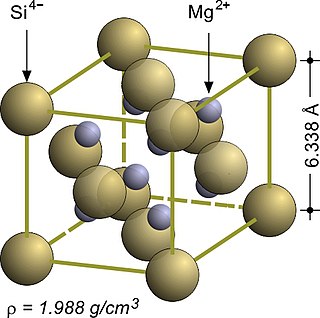
Peter Andreas Grünberg was a German physicist, and Nobel Prize in Physics laureate for his discovery with Albert Fert of giant magnetoresistance which brought about a breakthrough in gigabyte hard disk drives.

Magnesium silicide, Mg2Si, is an inorganic compound consisting of magnesium and silicon. As-grown Mg2Si usually forms black crystals; they are semiconductors with n-type conductivity and have potential applications in thermoelectric generators.
Exchange bias or exchange anisotropy occurs in bilayers of magnetic materials where the hard magnetization behavior of an antiferromagnetic thin film causes a shift in the soft magnetization curve of a ferromagnetic film. The exchange bias phenomenon is of tremendous utility in magnetic recording, where it is used to pin the state of the readback heads of hard disk drives at exactly their point of maximum sensitivity; hence the term "bias."
Tungsten silicide (WSi2) is an inorganic compound, a silicide of tungsten. It is an electrically conductive ceramic material.
Superferromagnetism is the magnetism of an ensemble of magnetically interacting super-moment-bearing material particles that would be superparamagnetic if they were not interacting. Nanoparticles of iron oxides, such as ferrihydrite, often cluster and interact magnetically. These interactions change the magnetic behaviours of the nanoparticles and lead to an ordered low-temperature phase with non-randomly oriented particle super-moments.
Erich Peter Wohlfarth was a theoretical physicist. He is known for his work in magnetism, in particular the Stoner–Wohlfarth model he developed together with his teacher E.C. Stoner.
Stuart Palmer FREng, also known as S. B. Palmer, is the honorary secretary of the Institute of Physics, and was the deputy vice-chancellor of the University of Warwick between 1999 and 2009. He is an emeritus professor of physics at Warwick who has worked in condensed matter physics and engineering physics and has extensively exploited the technique of ultrasound.
In physics, the Landau–Lifshitz–Gilbert equation, named for Lev Landau, Evgeny Lifshitz, and T. L. Gilbert, is a name used for a differential equation describing the precessional motion of magnetization M in a solid. It is a modification by Gilbert of the original equation of Landau and Lifshitz.
Alperm is a class of alloys comprising 83-90% of iron and 10-17% of aluminium. The most widely used composition is with 16% Al.

Cr23C6 is the prototypical compound of a common crystal structure, discovered in 1933 as part of the chromium-carbon binary phase diagram. Over 85 known compounds adopt this structure type, which can be described as a NaCl-like packing of chromium cubes and cuboctahedra.

Cobalt(II) selenide is an inorganic compound with the chemical formula CoSe. The mineral form of this compound is known as freboldite. Similar minerals include trogtalite (CoSe2) and bornhardtite (Co2+Co3+2Se4).
John Slonczewski was an American physicist known for his work on spin dynamics in magnetic systems.

Iron–platinum nanoparticles are 3D superlattices composed of an approximately equal atomic ratio of Fe and Pt. Under standard conditions, FePt NPs exist in the face-centered cubic phase but can change to a chemically ordered face-centered tetragonal phase as a result of thermal annealing. Currently there are many synthetic methods such as water-in-oil microemulsion, one-step thermal synthesis with metal precursors, and exchanged-coupled assembly for making FePt NPs. An important property of FePt NPs is their superparamagnetic character below 10 nanometers. The superparamagnetism of FePt NPs has made them attractive candidates to be used as MRI/CT scanning agents and a high-density recording material.

A permanent magnet motor is a type of electric motor that uses permanent magnets for the field excitation and a wound armature. The permanent magnets can either be stationary or rotating; interior or exterior to the armature for a radial flux machine or layered with the armature for an axial flux topology. The schematic shows a permanent magnet motor with stationary magnets outside of a brushed armature.

Europium hydride is the most common hydride of europium with a chemical formula EuH2. In this compound, europium atom is in the +2 oxidation state and the hydrogen atoms are -1. It is a ferromagnetic semiconductor.

Nickel monosilicide is an intermetallic compound formed out of nickel and silicon. Like other nickel silicides, NiSi is of importance in the area of microelectronics.
Neptunium arsenide is a binary inorganic compound of neptunium and arsenic with the chemical formula NpAs. The compound forms crystals.
Neptunium diarsenide is a binary inorganic compound of neptunium and arsenic with the chemical formula NpAs
2. The compound forms crystals.
Phosphide silicides or silicide phosphides or silicophosphides are compounds containing anions composed of silicide (Si4−) and phosphide (P3−). They can be considered as mixed anion compounds. They are distinct from the phosphidosilicates, which have the phosphorus bonded to the silicon. Related compounds include the phosphide carbides, germanide phosphides, nitride silicides, and antimonide silicides.

Terbium phosphide is an inorganic compound of terbium and phosphorus with the chemical formula TbP.








